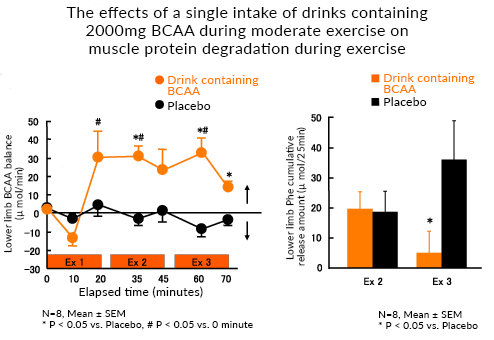Branched-chain amino acids and arginine supplementation attenuates skeletal muscle proteolysis induced by moderate exercise in young individuals
Matsumoto K, Mizuno M, Mizuno T, Dilling-Hansen B, Lahoz A, Bertelsen V, Münster H, Jordening H, Hamada K, Doi T
Int. J. Sports Med 2007; 28: 531-538
Objective
To evaluate the effects of a single intake of approximately 2,000mg of branched-chain amino acids (BCAA) during moderate exercise.
Methodology
Eight healthy adult volunteers (4 males, 4 females) with no regular exercise routine were each given either a drink containing BCAA (2g/500mL) or an isocaloric placebo drink, and a double-blind crossover study performed. The subjects performed three sets of moderate cycling exercises (at 126 +/- 13W, or 50% of maximum workout intensity) for a total of one hour and were administered a single serving of the test drink while exercising. Blood samples were taken from the radial artery and femoral vein before starting the exercise and at ten-minute intervals during the exercise. Blood flow in the femoral artery was measured using the Doppler ultrasound technique*1. Phenylalanine (Phe) balance*2, an indicator of muscle proteolysis, was derived using the arteriovenous difference method*3.
- *1Doppler Ultrasound Technique: A technique whereby the speed of an object moving through the body is measured by applying ultrasonic waves to the target object
- *2Phenylalanine (Phe) Balance: a metabolic pathway through which Phe is either utilized in protein synthesis in the muscles and taken in by muscle proteins or expelled from muscle proteins via proteolysis. Consequently, intake of Phe into the muscles reflects a net synthesis of muscle proteins, whereas release of Phe from the muscles reflects net muscle proteolysis.
- *3Arteriovenous difference method: calculates the balance between intake and release of amino acids in active muscle groups using values for amino acid concentrations and arterial blood flow determined by taking simultaneous blood samples from the arteries and veins. Derived using the formula: (arterial blood concentration - venous blood concentration) × blood flow.
Results
The single intake of 2,000mg of BCAA during exercise significantly increased BCAA concentration levels in the blood, and the increased BCAA was taken in by the skeletal muscles. No changes, however, were observed in blood BCAA concentrations, nor the interaction of BCAA with the skeletal muscles when the placebo drink was given. Phe release from the skeletal muscles during exercise increased significantly compared to pre-workout levels when given the placebo drink, whereas ingestion of the BCAA-containing drink significantly inhibited the release of Phe from the skeletal muscles.
Conclusions
The results suggest that taking drinks containing BCAA during exercise enhances the uptake of BCAA in active muscles and is effective in inhibiting muscle proteolysis during moderate exercise.










